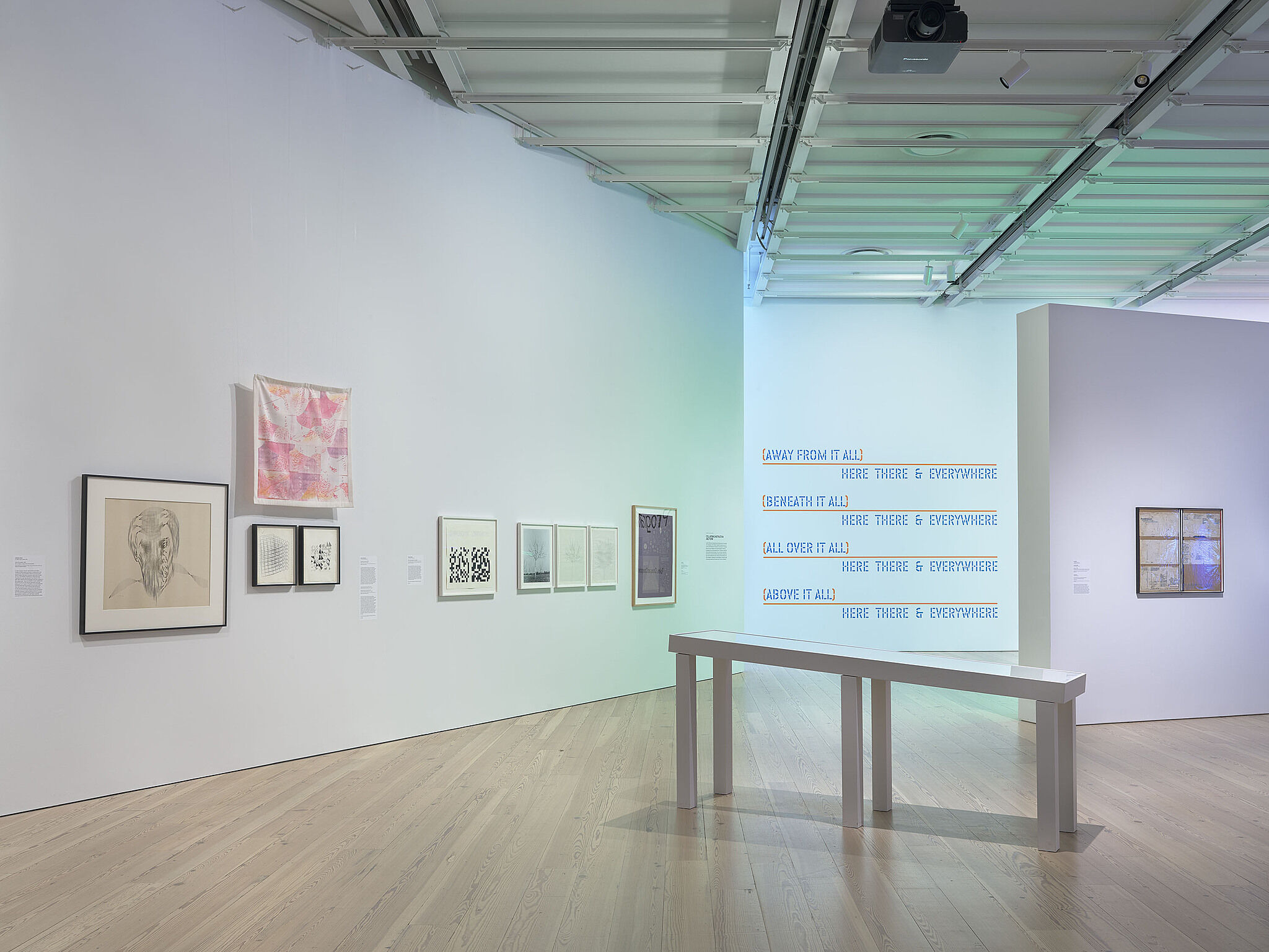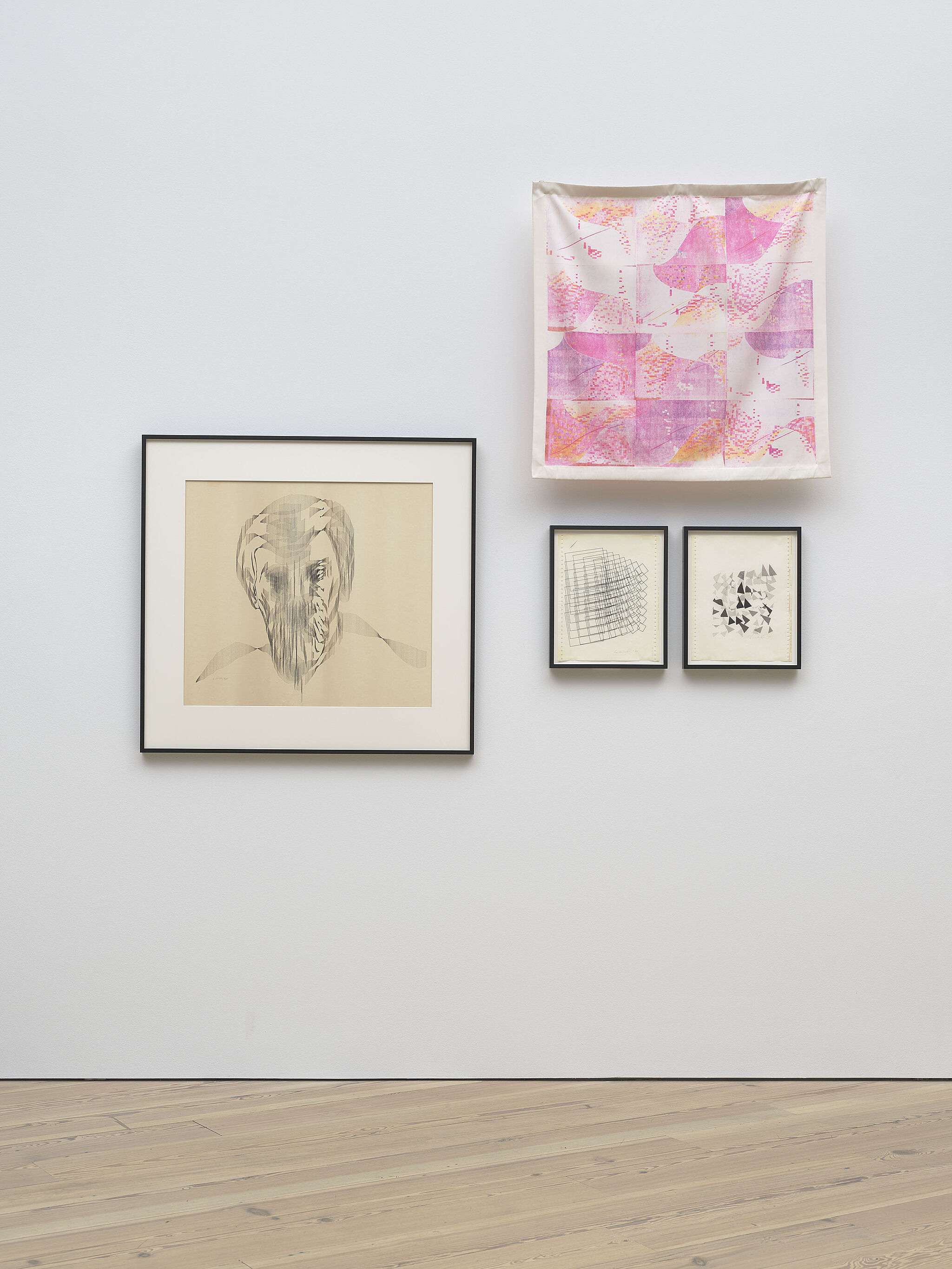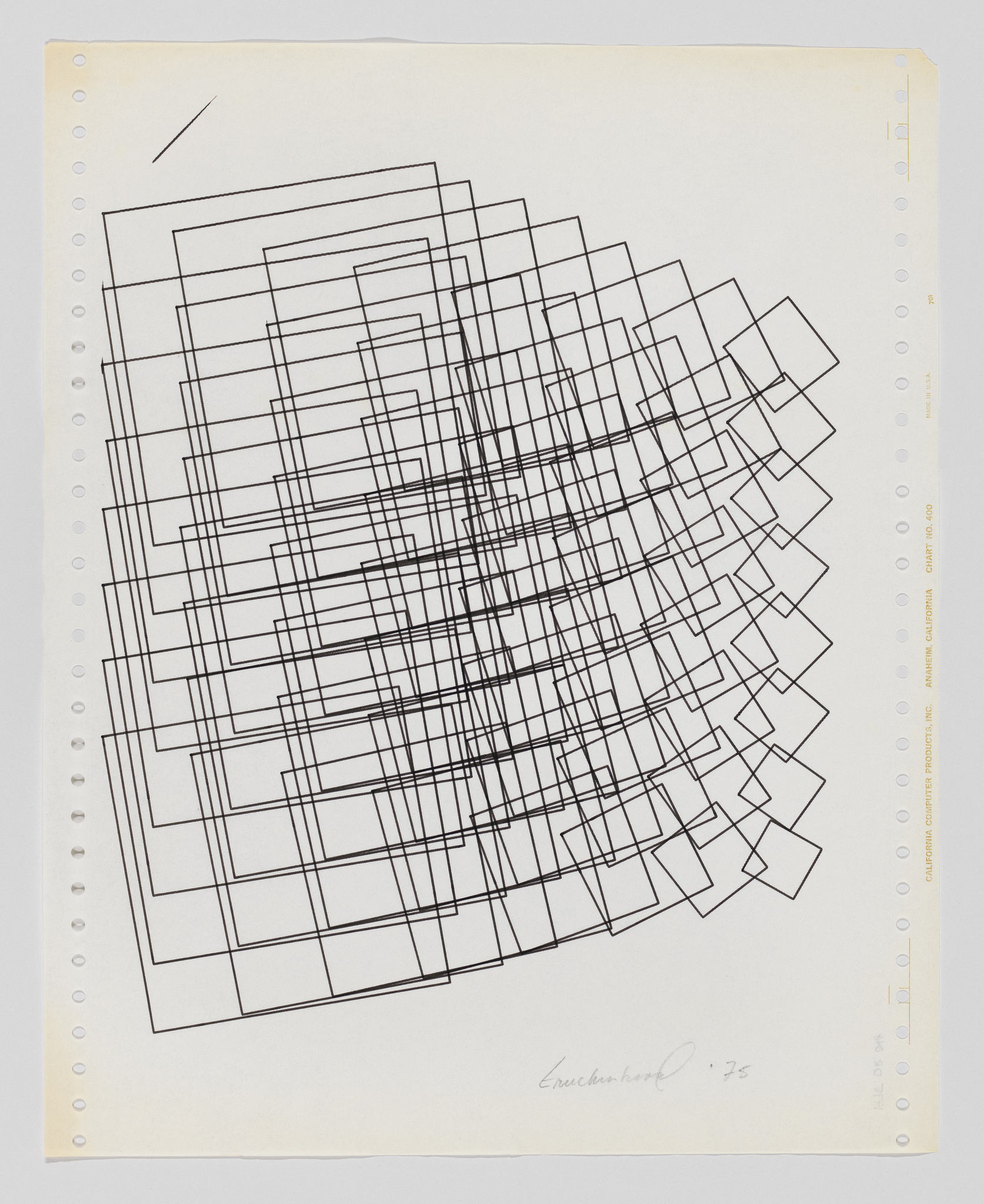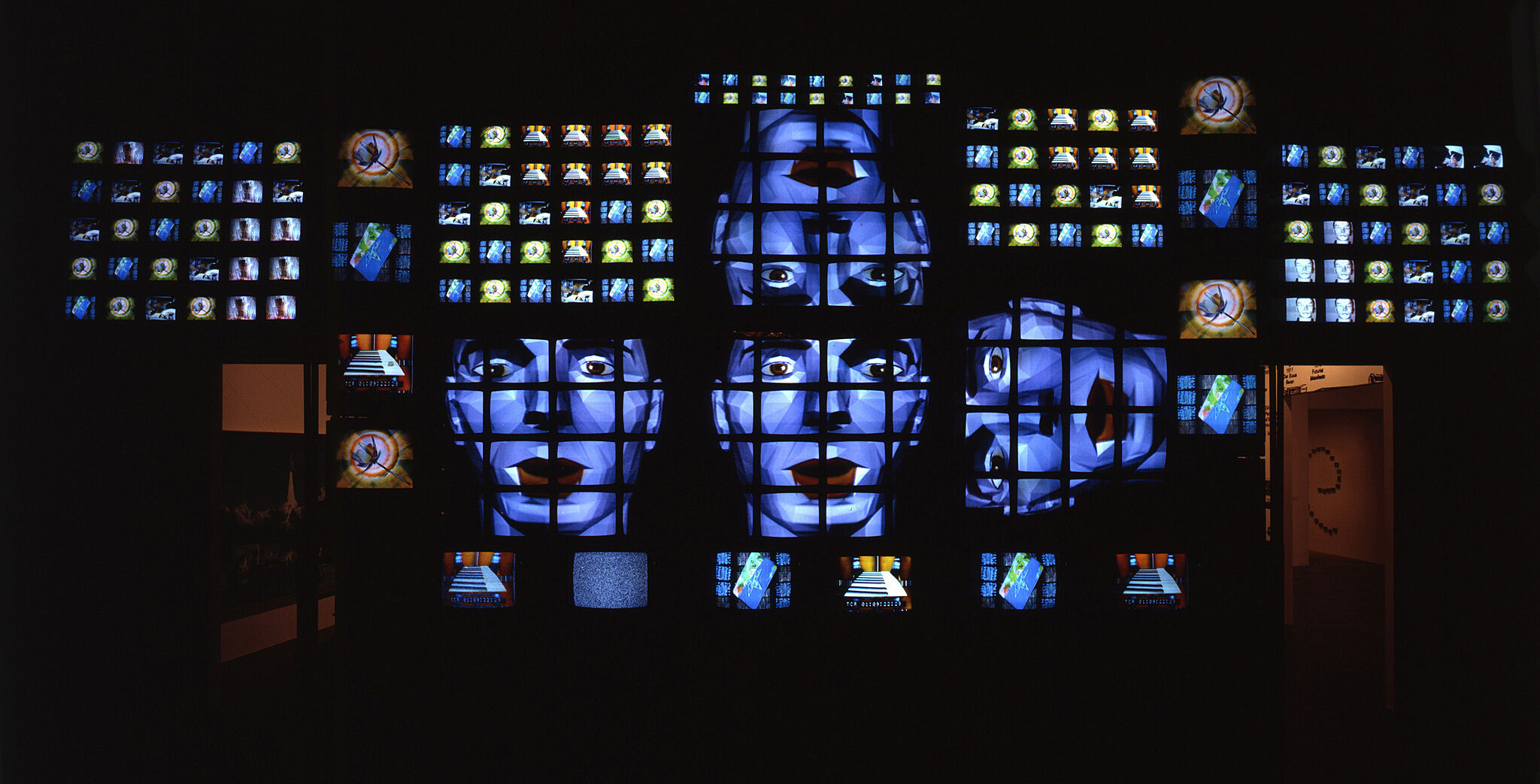Not on view
Date
1975
Classification
Drawings
Medium
Plotter pen and ink on paper
Dimensions
Sheet: 15 5/8 × 12 3/8in. (39.7 × 31.4 cm)
Accession number
2018.49
Credit line
Whitney Museum of American Art, New York; purchase, with funds from the Digital Art Committee
Rights and reproductions
© Joan Truckenbrod
Audio
-
Joan Truckenbrod, Coded Algorithmic Drawings, 1975
In Programmed: Rules, Codes, and Choreographies in Art, 1965–2018 (Spanish)
0:00
Joan Truckenbrod, Coded Algorithmic Drawings, 1975
0:00
Joan Truckenbrod: Cuando comencé, estaba muy interesado en poder hacer una impresión o una imagen de las fuerzas invisibles del mundo natural, en la que fueran palpables pero invisibles. No tenía interés en dibujarlas, pintarlas o fotografiarlas. Me interesaba más obtener una expresión, una experiencia o una impresión. Luego, fue evidente que podía hacer una marca con la computadora.
Pero entonces descubrí que existían, de hecho, fórmulas matemáticas que describían algunos de estos fenómenos, por lo que podía desarrollar algoritmos aplicando estas fórmulas algebraicas y luego integrarlos a programas informáticos para crear, por lo general, una serie de imágenes. A veces, las series se dibujaban de manera lineal, una a la vez, y el estilo del texto se realizaba de esa manera. Otras veces, la serie o la secuencia se superponían, por lo que se obtenía una sensación de movimiento y profundidad que expresaba, de alguna manera, la trayectoria de esa serie. Siempre concibo la naturaleza como algo en movimiento. . . pienso que hay una trayectoria que interpretan, como patrones de crecimiento u ondas de luz o corrientes de aire en movimiento, cosas como las series de hojas en un árbol en particular.
Intenté expresar eso mismo por medio de la programación.
-
Joan Truckenbrod, Coded Algorithmic Drawings, 1975
In Programmed: Rules, Codes, and Choreographies in Art, 1965–2018
0:00
Joan Truckenbrod, Coded Algorithmic Drawings, 1975
0:00
Joan Truckenbrod: When I started, I really was interested in making an impression or an image of invisible forces in the natural world that were palpable but invisible. I wasn't really interested in drawing them, or painting them, or photographing them. I was more interested in an expression, or an experience, or an impression of them. Then it became obvious that I could make a mark with a computer.
But I then discovered that there were in fact mathematical formulas that described some of these phenomena so I could develop algorithms using these algebraic formulas and then integrate them into computer programs so that I created usually a series of images. Sometimes the series were drawn out in a linear way, like one at a time, and the text style was done in that way. Or sometimes, the series or the sequence would be superimposed on one another, so you'd get the sense of motion and depth that expressed that series, sort of the trajectory. I always think of nature as not being still, but that there's a trajectory, that they play out, like growth patterns or light waves undulating or wind currents moving, things like the series of leaves on a particular tree.
I tried to express that through programming.
Exhibitions
Installation photography
-


Installation view of Programmed: Rules, Codes, and Choreographies in Art, 1965–2018 (Whitney Museum of American Art, New York, September 28, 2018–April 14, 2019). From left to right, top to bottom: Casey Reas, {Software} Structures #003 B, 2004 and 2016; Sol LeWitt, 4th wall: 24 lines from the center, 12 lines from the midpoint of each of the sides, 12 lines from each corner, 1976; Manfred Mohr, Band Structures P-021-U, 1970–83; Joan Truckenbrod, Curvilinear Perspective, 1979; Joan Truckenbrod, Coded Algorithmic Drawing (#9), 1975; Joan Truckenbrod, Coded Algorithmic Drawing (#45), 1975; In vitrine: Channa Horwitz, Suite 8, 1979. Photograph by Ron Amstutz
From the exhibition Programmed: Rules, Codes, and Choreographies in Art, 1965–2018
-


Installation view of Programmed: Rules, Codes, and Choreographies in Art, 1965–2018 (Whitney Museum of American Art, New York, September 28, 2018–April 14, 2019). From left to right, top to bottom: Manfred Mohr, Band Structures P-021-U, 1970–83; Joan Truckenbrod, Curvilinear Perspective, 1979; Joan Truckenbrod, Coded Algorithmic Drawing (#9), 1975; Joan Truckenbrod, Coded Algorithmic Drawing (#45), 1975. Photograph by Ron Amstutz
From the exhibition Programmed: Rules, Codes, and Choreographies in Art, 1965–2018
-


Installation view of Programmed: Rules, Codes, and Choreographies in Art, 1965–2018 (Whitney Museum of American Art, New York, September 28, 2018–April 14, 2019). From left to right, top to bottom: Manfred Mohr, Band Structures P-021-U, 1970–83; Joan Truckenbrod, Curvilinear Perspective, 1979; Joan Truckenbrod, Coded Algorithmic Drawing (#9), 1975; Joan Truckenbrod, Coded Algorithmic Drawing (#45), 1975; Tauba Auerbach, Binary Uppercase/Lowercase, 2005; Charles Gaines, Walnut Tree Orchard: M1, M2, M3, 1977; Agnes Denes, Pascal’s Triangle II, 1974; Lawrence Weiner, HERE THERE & EVERYWHERE, 1989; In vitrine: Channa Horwitz, Suite 8, 1979. Photograph by Ron Amstutz
From the exhibition Programmed: Rules, Codes, and Choreographies in Art, 1965–2018
-


Installation view of Programmed: Rules, Codes, and Choreographies in Art, 1965–2018 (Whitney Museum of American Art, New York, September 28, 2018–April 14, 2019). From left to right, top to bottom: Charles Csuri, Sine Curve Man, 1967; Joan Truckenbrod, Curvilinear Perspective, 1979; Joan Truckenbrod, Coded Algorithmic Drawing (#9), 1975; Joan Truckenbrod, Coded Algorithmic Drawing (#45), 1975; Tauba Auerbach, Binary Uppercase/Lowercase, 2005; Charles Gaines, Walnut Tree Orchard: M1, M2, M3, 1977; Agnes Denes, Dialectic Triangulation: A Visual Philosophy, series #3, 1970; Lawrence Weiner, HERE THERE & EVERYWHERE, 1989; Sol LeWitt and Lucinda Childs, Dance #4, 1979. Photograph by Ron Amstutz
From the exhibition Programmed: Rules, Codes, and Choreographies in Art, 1965–2018
-


Installation view of Programmed: Rules, Codes, and Choreographies in Art, 1965–2018 (Whitney Museum of American Art, New York, September 28, 2018–April 14, 2019). From left to right, top to bottom: Charles Csuri, Sine Curve Man, 1967; Joan Truckenbrod, Curvilinear Perspective, 1979; Joan Truckenbrod, Coded Algorithmic Drawing (#9), 1975; Joan Truckenbrod, Coded Algorithmic Drawing (#45), 1975. Photograph by Ron Amstutz
From the exhibition Programmed: Rules, Codes, and Choreographies in Art, 1965–2018


